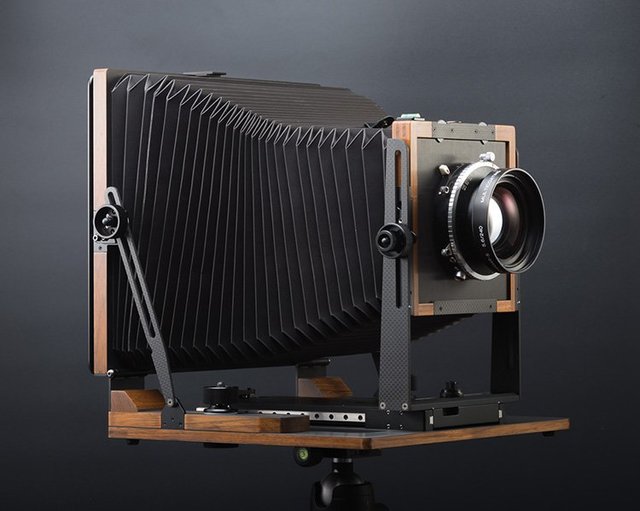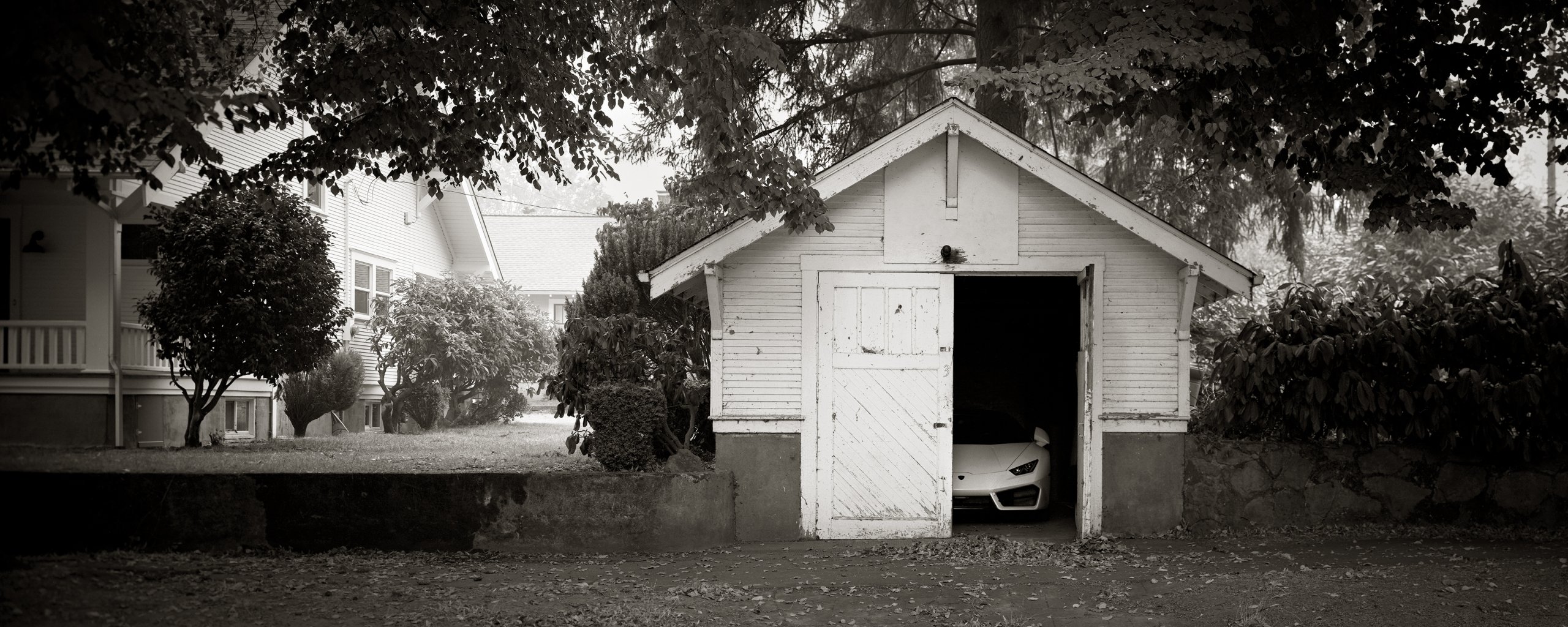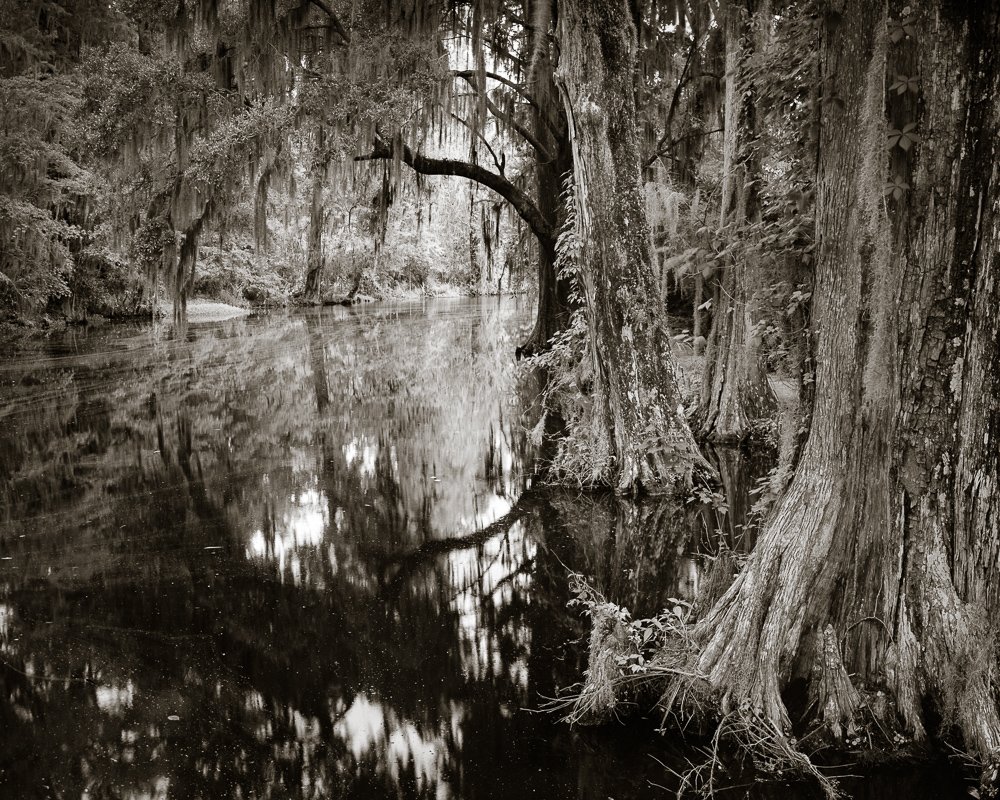Each format has its advantages and disadvantages, which we’ll explore in some depth one area at a time, beginning with physical size.
Size
8×10″ film is 4x the surface area of 4×5.” Therefore, everything must of necessity be four times larger.
Your lenses will each need to cover 8×10″ with enough additional coverage to provide adequate coverage when movements such as front or rear rise, tilt, shift, and swing are applied to the camera’s standards. For this reason, you cannot necessarily use 4×5″ lenses with your 8×10.” If you plan to shoot both formats, however, you can simply purchase lenses that you know will cover 8×10,” and use them with both 8×10″ and 4×5.” This is because all lenses that cover 8×10″ will cover 4×5″ with a lot of room to spare, but many 4×5″ lenses will not provide sufficient coverage for 8×10.”
Dark cloths will also need to be larger to accommodate 8×10.” Many dark cloths have adjustable collars that can be adjusted to fit the rear standards of either format. Fellow Darkslides member Ryan Gillespie makes excellent dark cloths through his Wanderer brand which do just this and are among the best in the industry.
You will also need to invest in a way to change 8×10″ film if you size up to 8×10.” Many changing bags and tents made for 4×5″ and smaller formats will not work with 8×10.” Like the other accessories, a changing tent that works with 8×10″ will be an absolute palace for 4×5,” so if you think you may ever work with 8×10″ in the future, keep this in mind when shopping for a changing tent or bag. Changing tents tend to be easier to work with than bags, but bags offer much more portability when traveling.
Tripods are another area where you may need to make further investments in order to accommodate 8×10.” All 8×10″ cameras are far larger than other cameras out of sheer necessity, regardless of how light or heavy they are, and all of them likewise benefit from a very stable tripod. The cameras are so large (mostly due to the size of the bellows) that they effectively become a sail during windy conditions, and the tripod plays a major role in making photography possible when the winds pick up. If you utilize compositions that require the camera to be tipped forward or backward, having a stable tripod becomes even more important. As with each of the other categories, investing in a stable tripod will benefit your other camera systems and formats as well.
It probably goes without saying, but you will need to invest in a collection of 8×10″ film holders as well. While this is not a “difference” per se, the larger film holders cost a great deal more (disproportionately so) than their 4×5″ counterparts, so the added expense, weight, and bulk of these larger film holders is something you’ll want to consider when evaluating whether to size up or not.
Lens boards are another area of consideration when thinking about upsizing to 8×10.” You will likely want to invest in an adapter board that will allow you to mount your 4×5″ lens boards on your new 8×10.” For example, I use a Sinar to Linhof adapter board that lets me mount standard Linhof boards onto my 8×10,” despite the Linhof standard being designed for 4×5″ cameras. This means I can use all my lenses on both my 4×5″ and 8×10″ view cameras without the hassle of changing lens boards, which requires disassembling the lens with a spanner wrench – not something you want to do every day if you can avoid it.
Weight
As a general rule, 8×10″ cameras tend to weigh at least twice as much as their 4×5 counterparts. This is obviously better than the 4x increase that would seem to be in order considering the increase in surface area, but it is still a major jump in the weight you have to carry to every photo location. Some of the newer 8×10″ field cameras have come down quite a bit in weight, with the Intrepid 8×10″ clocking in at just over 5 pounds and the Chamonix Alpine (landscape orientation only) 8×10″ coming in at just under 6. Most of the other cameras tend to weigh quite a bit more, often in the 11-13 pound range.
Cost
The cost of the cameras, lenses, film holders and other accessories tends to go up quite substantially with 8×10.” This is not only due to the sheer size but also due to the economics of supply and demand. Large format photography of any kind is already a very small niche within photography, and 8×10″ is a much smaller niche than 4×5.” For this reason, cameras and accessories created to serve the 8×10″ market need to cost a lot more because far fewer copies will ever be sold, while the overhead costs of production tend to be higher. This effect compounds in the used market, with far fewer used copies of any given camera or lens being available. This tends to drive values up over time as used cameras and lenses wear out and the available supply of functioning units contracts further.
Image Quality
If we are honest with ourselves, we all know that 4×5″ provides far more than enough detail resolution than any of us will likely ever need, especially with access to drum scanning services like those provided by Alex Burke and Michael Strickland. Even a simple flatbed scan can provide around 186MP of resolution on the Epson V700 & 800 series scanners, for example. (I use megapixels rather than megabytes as a measure of resolution because these are the units used by the digital camera industry and those we all understand.)
However, for those of us who demand only the best or are simply gluttons for punishment, the 8×10″ format can provide over 700MP of file resolution, blowing away everything else available.
Keep in mind, film resolution does not work the same way as digital, as most digital cameras use Bayer array sensors, which consist of separate red, green, blue, and brightness photosites for each pixel, whereas film contains an organic grain blend of color and luminosity values at every spot on the film, with much finer gradations of color and tone throughout. For this reason, even small film formats can often look subjectively better than digital formats of much higher resolutions when scanned.
In summary, almost no one needs the detail provided by 8×10″ film, but it sure is nice to experience! One application where the added detail of 8×10″ does come in handy is that of printing large murals and wall-sized art installations many feet wide or tall. Because 8×10″ provides more resolution, you can print these large sizes at a much higher DPI which looks much better when viewed close up.
Depth of Field
Most of you are probably familiar with the rather silly debates about the decreased depth of field when moving from APS-C to 35mm “full-frame” digital sensors. It should be obvious why I use quotation marks to say that when we consider these tiny sizes in light of all the medium and large format sizes that are far larger and therefore have a far shallower depth of field. With large format, we find that the depth of field plane is so thin that it makes camera movements and very narrow apertures a necessity in order to get anything substantial in focus in a scene. It is for this reason that most large format cameras use a bellows design that allows for extensive camera movements to be applied in order to manipulate that thin depth of field plane in 3-dimensional space. It is also why large format lenses tend to stop down much farther than their small and medium format counterparts. Minimum apertures ranging from f/32 to as small as f/256 are not uncommon with large format lenses.
8×10″ film cameras have a much thinner depth of field plane than their 4×5″ counterparts. This can make getting a scene in focus from front to back and edge to edge very challenging. Because of this, it may take longer to adjust camera movements to just the exact right configuration required to obtain the maximum possible depth of field for any given scene with 8×10.” You may also need to stop down further in some cases.
The good news is, the procedure for setting up camera movements is exactly the same with 8×10″ as with 4×5,” and with a little practice, you can become familiar enough with focusing an 8×10″ camera that you can comfortably switch back and forth between the large formats without much if any difficulty.
Ground Glass and Composition
One tremendous benefit of 8×10″ film cameras is their massive ground glass, which makes composing absolutely delightful and much easier and more pleasant than it is already with 4×5.” While composing with a 4×5″ ground glass feels like a magical experience, 8×10″ is even more so, and even could be described as sublime.
Conclusion
8×10″ film essentially has all of the aspects of 4×5″ photography but multiplied by 4. If you love 4×5″ you will probably love 8×10″ even more. However, you must consider all the tradeoffs involved, such as the increases in size, weight, and cost. Each medium has its strengths and weaknesses. For example, 4×5″ tends to be much easier and lighter to carry on backpacking trips and when traveling by airplane or other public transportation. 8×10″ tends to be nicer for studio work and landscape work that happens close to the car. Only the pure diehards will be willing to take an 8×10″ view camera deep into the backcountry or on a long flight. However, for those of us who are willing to put in the work and accept the compromises involved in 8×10″ photography, the rewards are equally substantial.




0 Comments